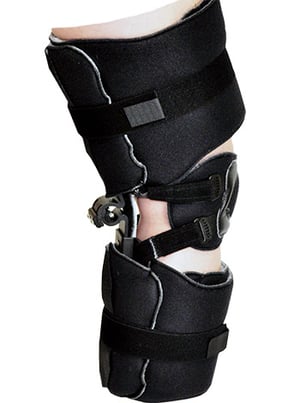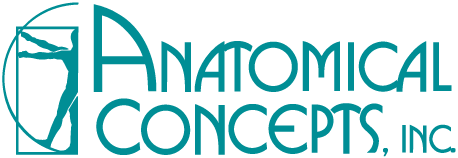CASE STUDIES
Launching the Knee Management Orthosis (KMO)
For acute knee injuries, knee immobilizers are typically the industry standard. They allow for proper healing by keeping the knee straight, and can also be removed to allow gentle motion. However, its lack of adjustability can limit its use in certain cases. Knee immobilizers are typically built with a malleable aluminum posterior bar that be bent to provide the patient with some flexion, or bending of the knee. Conforming the device to the patient can take extra time, which isn’t ideal in the emergency room.
In the late 1990s, Anatomical Concepts developed its APU – a jointed posterior heel connecting bar designed to use with its foot/ankle products to allow more positional capabilities about the foot and ankle. At a tradeshow, Robert Lin, CPO, (Certified Orthotist/Prosthetist) commented on how the design would work nicely on a knee brace if the joint were positioned behind the knee. ACI’s R&D team worked with Lin to design and develop a prototype that reconfigured the APU joint to work on a posterior upright knee brace. Lin evaluated the prototype and introduced it to his physicians who specialized in pediatric orthopedics.
After determining the prototype would work in a clinical setting, ACI applied for the patent and the KMO was born. It has been used successfully in medical facilities worldwide for more than 20 years.
KMO benefits include:
- Posteriorly located joint system prevents issues with medial/lateral joint congruity
- Easy re-application of the orthotic by the patient
- Infinite adjustability to accommodate multiple situations
- Can be locked in a fixed position of knee flexion or extension to assist with walking during rehab training
- Provides a simple, cost-effective stabilization solution for the entire patient rehab process

A Clinical Case Study
A 12-year-old club soccer player sustained a knee injury during a weekend tournament. The contact injury resulted in immediate joint effusion, or ‘water on the knee’, causing the knee to swell. The pain made it almost impossible for her to bend or fully extend her knee.
After ruling out any fractures, the ER resident on-call temporarily stabilized the patient’s knee in a fixed 35 degrees of flexion using a posterior fiberglass trough splint secured with an Ace wrap. This process alone took 30 minutes, and the resident had four other patients to see.
It would take another five to seven days to schedule additional diagnostic scans and an orthopedic workup, so immediate stabilization of the knee was critical. Because of the patient’s pain-restricted extension, she couldn’t be fit with a standard knee immobilizer due to the flexion. Fitting her with a traditional Posterior Range of Motion (PROM) OTS brace also wouldn’t work because it was cost-prohibitive for such a short application period.
The Solution
The orthotist on-call fit the patient with the KMO, which only took five minutes. The KMO’s unique posterior strut and popliteal joint mechanism provided infinite adjustment options, making it easy to accommodate the required 35 degrees of flexion.
 330-757-3569
330-757-3569




